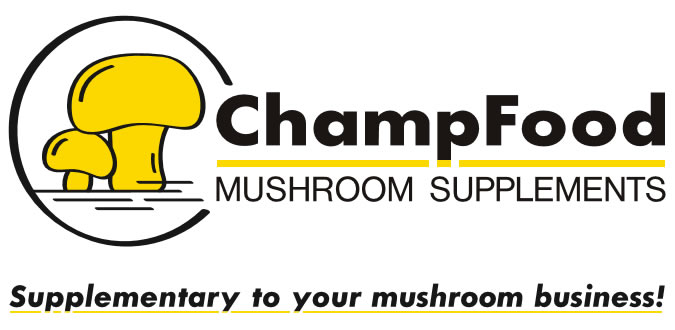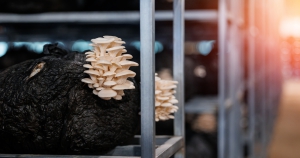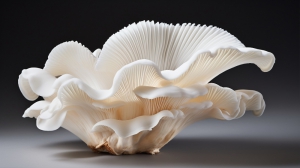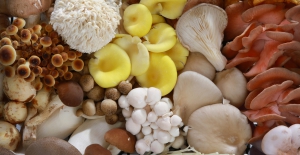
Mushroom Matter
Welcome on our platform. Why MUSHROOM MATTER? Because mushrooms play an important role in our lives as well in business. Our goal is to bring the world the very latest mushroom news with the upmost care to support the positioning of our beloved Mushroom.
As the mushroom industry continues to evolve, one of the most exciting frontiers is happening beneath the surface, literally. The development of smarter, more sustainable substrates is redefining how mushrooms are cultivated, improving efficiency, productivity, and environmental impact all at once.
The hidden power of the substrate
Every mushroom farmer knows that success begins with the substrate. It’s not just a growing medium, it’s the foundation of the entire production process. Traditionally made from agricultural by-products such as straw, manure, or sawdust, substrates are now being optimized through a combination of science and technology.
Researchers and commercial producers alike are exploring new blends that enhance nutrient availability, moisture retention, and microbial balance. These improvements allow mushrooms to grow faster, stronger, and with more consistent quality across flushes.
Data meets biology
Technology is playing a crucial role in unlocking the full potential of substrate science. Precision monitoring tools, AI-driven analysis, and smart sensors are allowing farmers to better understand what’s happening at the microbial level.
By analyzing temperature profiles, CO₂ emissions, and biological activity in real time, growers can fine-tune conditions to ensure optimal colonization and fruiting. This data-driven approach helps reduce energy costs, minimize contamination, and ultimately increase yields, all while maintaining product quality.
Sustainability from start to finish
The move toward sustainable substrates reflects a broader shift in the mushroom industry toward circularity. Agricultural waste streams, such as coffee grounds, brewery grains, and nut shells, are being repurposed as feedstock for mushroom cultivation.
After harvesting, spent mushroom substrate (SMS) is being given new life as compost, animal feed, or soil enhancer, closing the loop in a truly regenerative production model. This approach not only reduces environmental impact but also creates added value from every stage of the cultivation cycle.
Growing smarter, not harder
As consumer demand for mushrooms and functional fungi continues to rise, the industry’s ability to innovate from the ground up will define its future. The next generation of substrates, designed with precision, sustainability, and circularity in mind, will help growers meet global demand efficiently and responsibly.
In the world of mushrooms, it’s clear that what happens beneath the surface can make all the difference above it.
Published by Mushroom Matter: connecting the global mushroom community through insight, innovation, and inspiration
The mushroom industry is entering a digital era. What was once guided solely by intuition, experience, and manual labor is now increasingly supported by sensors, automation, and data analytics. From substrate preparation to harvest, smart farming tools are reshaping how fungi are grown, making production more precise, efficient, and sustainable than ever before.
Precision growing in every layer
Inside modern growing rooms, environmental control systems are evolving into intelligent ecosystems. Sensors monitor temperature, humidity, CO₂ levels, and air circulation in real time. Artificial intelligence (AI) algorithms then adjust these factors automatically, ensuring ideal conditions for each growth phase.
This precision doesn’t just boost yields, it reduces energy consumption and minimizes human error. Instead of reacting to issues after they occur, farmers can anticipate and prevent them, achieving higher consistency and quality across crops.
Data as the new substrate
For decades, mushroom cultivation relied heavily on experience, the grower’s eye and intuition. Those remain invaluable, but now they’re being amplified by data. Smart platforms can collect thousands of data points per day, translating them into actionable insights: when to ventilate, irrigate, or adjust temperature.
Some farms use cloud-based dashboards that visualize performance across different growing rooms or even multiple sites. Others are experimenting with machine learning to recognize growth patterns and predict harvest times with remarkable accuracy.
In short, the farm is learning, and so are the fungi.
Automation lightens the load
Labor shortages have long been a concern in the mushroom sector. Smart technologies are helping to bridge that gap. Automated systems can handle repetitive or heavy tasks such as substrate loading, climate adjustments, or even mushroom picking with robotic precision.
While full automation isn’t feasible for every operation, even partial adoption, for example, using camera-guided monitoring or automated watering, significantly reduces workload while improving consistency. The result: growers can focus more on strategy, quality, and innovation instead of routine maintenance.
A sustainable shift
Beyond efficiency, smart farming supports a more sustainable production model. By fine-tuning environmental parameters, farms use less energy and water. Precise climate control minimizes waste, and optimized substrate management helps reduce contamination rates.
For forward-thinking producers, data also helps demonstrate sustainability performance to customers and investors, turning eco-efficiency into a measurable, marketable advantage.
The human touch remains
Even in the smartest farms, technology doesn’t replace people, it empowers them. Successful growers combine digital insights with hands-on experience and instinct. The art of mushroom cultivation remains rooted in understanding living organisms; technology simply provides new tools to nurture them better.
The road ahead
Smart farming in mushrooms is still in its early stages, but the direction is clear. With each innovation, whether AI-driven control, autonomous harvesters, or cloud-based analytics. the boundary between biology and technology grows thinner.
As these systems become more accessible and affordable, farms of all sizes can benefit from the data revolution. The result? Smarter farms, smarter fungi, and a more resilient, sustainable future for the entire mushroom industry.
Published by Mushroom Matter: connecting the global mushroom community through insight, innovation, and inspiration
The humble mushroom is quietly taking center stage in a global shift toward sustainable living, healthy eating, and circular innovation. Once considered a niche ingredient or a simple forest delicacy, fungi are now at the heart of scientific breakthroughs, environmental solutions, and a booming wellness economy.
From food to function: mushrooms go mainstream
In kitchens and cultivation facilities across the world, mushrooms have become more than a culinary delight, they’re a cornerstone of functional nutrition. The demand for lion’s mane, cordyceps, and reishi continues to grow as consumers seek natural ways to support focus, energy, and immunity. Analysts estimate the global functional mushroom market could surpass $20 billion within the decade, driven by both consumer wellness trends and research into compounds like beta-glucans and hericenones.
For mushroom growers, this trend opens new opportunities beyond traditional button or oyster cultivation. Specialty fungi command higher margins, require less land and water, and appeal to a rapidly diversifying customer base—from wellness brands to supplement formulators.
Mycelium: the root of innovation
Outside the kitchen, mycelium, the root-like network that forms the body of a fungus, is emerging as one of the most exciting biomaterials on Earth. Startups and researchers are developing mycelium-based packaging, textiles, and construction materials that rival plastics, leather, and even concrete. Unlike synthetic materials, mycelium grows naturally from agricultural waste and fully biodegrades, offering a true circular alternative.
Recent progress in Europe and North America shows mycelium composites being adopted for protective packaging, furniture, and even soundproofing panels. For the mushroom industry, these ventures create new synergies: growers can repurpose waste substrates into valuable bioproducts, closing the sustainability loop.
The Future: mushrooms as climate partners
As agriculture faces increasing pressure from climate change, fungi could play a vital role in regenerating soil health and reducing carbon emissions. Mycorrhizal fungi, those that form symbiotic relationships with plant roots—enhance soil structure, boost nutrient uptake, and lock away carbon underground. Forward-thinking farmers are exploring mushroom-integrated systems where fungi coexist with crops to improve yields and biodiversity.
Meanwhile, food innovators are experimenting with mycoprotein-based meat alternatives that deliver both nutrition and sustainability, requiring a fraction of the water and land of traditional livestock.
The bottom line
From the lab to the forest, and from the farm to the factory, fungi are rewriting what’s possible in food, health, and materials science. For mushroom farmers and industry professionals, the message is clear: we are not just growing mushrooms, we are cultivating the future.
Published by Mushroom Matter: connecting the global mushroom community through insight, innovation, and inspiration
The mushroom sector is entering a transformative phase, where farming tradition meets cutting-edge innovation. Once seen simply as a niche crop, mushrooms are now emerging as powerful contributors to sustainable agriculture, human wellness, and even material science.
Shaping a circular food system
One of mushrooms’ greatest strengths lies in their resource efficiency. Unlike many crops, they flourish on byproducts such as straw, sawdust, or coffee grounds, making them natural allies in the shift toward circular farming. For growers, this opens opportunities to reduce waste, diversify substrates, and partner with other agricultural industries to create closed-loop systems.
Health on the rise
Consumer interest in functional and nutrient-rich foods continues to surge, and mushrooms are at the forefront. Varieties like Lion’s Mane and Reishi are valued for their adaptogenic potential, while everyday favorites such as oyster and button mushrooms are being recognized for their protein, fiber, and vitamin D. This dual reputation, both as staple food and functional ingredient, is fueling new product development across the food and supplement industries.
Farming smarter with technology
The drive toward efficiency and scalability has accelerated adoption of digital tools. Automated climate systems, AI-based monitoring, and sensor-driven data analytics are helping growers fine-tune production while tackling labor shortages. Farms that embrace these technologies are finding new ways to improve yields, cut costs, and meet rising demand with consistency.
Beyond the plate
Mushrooms are increasingly breaking into non-food markets. Mycelium, the root-like structure of fungi, is now being used to create biodegradable packaging, sustainable textiles, and even construction materials. These developments highlight the mushroom industry’s potential to play a role far beyond food, positioning it as a cornerstone of sustainable innovation.
Building a future-ready industry
As mushrooms gain attention worldwide, the industry faces both opportunity and responsibility. Growth must balance innovation with sustainability, ensuring practices that protect natural resources while meeting expanding consumer expectations. Collaboration between farmers, researchers, and entrepreneurs will be vital in keeping the sector resilient.
Mushrooms today are not only a crop but a vision of what agriculture and innovation can achieve together. For farmers and industry leaders, the message is clear: cultivating mushrooms means cultivating the future.
In the following weeks we'll dive deeper into theses subjects. Do you have expertise, research or success stories on these subjects that can inspire others? Reach out and let’s share your voice with our readers!
Published by Mushroom Matter: connecting the global mushroom community through insight, innovation, and inspiration
A study from Singapore shows that people who eat more than two portions of mushrooms per week have a 47% lower risk of developing Mild Cognitive Impairment (MCI).
What is MCI?
MCI is a condition in which memory, concentration, or other cognitive functions are slightly below what is normal for one’s age, while daily functioning remains largely intact. It is considered an early warning sign of dementia, though not every case of MCI progresses to it.
How mushrooms help
Scientists believe that certain compounds in mushrooms, such as antioxidants and bioactive substances may help protect brain cells from oxidative stress.
Important to know
The study is observational: it shows associations, but not necessarily cause-and-effect.
Further research and clinical studies are needed to understand exactly which mushroom varieties and dosages are most effective.
Published by Mushroom Matter: Inspired by research published via PMC (National Library of Medicine)
When you think of mushrooms, you might picture them on your plate. But researchers in Spain are showing how fungi can also shape the future of packaging. Their latest project turns mushroom mycelium into a biodegradable, durable material that can replace plastic.
This is part of a growing global movement: companies in the US, Europe, and Asia are all exploring how fungi can tackle one of the world’s biggest waste challenges. By transforming side streams and agricultural by-products into packaging, mycelium offers a double win, reducing plastic pollution and making better use of resources.
For mushroom growers and industry players, it’s another example of how fungi are stepping outside the farm and into mainstream innovation.
by Mushroom Matter
Ecovative, a pioneer in mycelium-based technologies for sustainable food and materials, today announced the sale of its Netherlands-based subsidiary, Ecovative Spawn & Substrate BV, to the Klerken family, founders of Scelta Mushrooms.
Under the Klerken family’s ownership, the business will be renamed OurCelia, marking a new chapter in its support of the mushroom industry and introducing new solutions to mushroom farmers globally. This transition reflects a marriage of strengths: Ecovative’s leadership in mycelium innovation, stretching two decades, and the Klerken family’s deep roots in the global mushroom industry, dating back to 1963. Together, the two organizations will maintain a close, long-term relationship to advance the supply of world-class spawn products to both mushroom and mycelium producers. Ecovative previously acquired Lambert Spawn Netherlands in 2022 from its U.S. parent company, Lambert Spawn, founded in 1919 and recognized as the world’s oldest spawn producer. With this foundation, the Dutch spawn activities are now continuing under the Klerken family as OurCelia.
“Ecovative is proud to have grown the global supply chain for Agaricus and AirMycelium spawn from the Netherlands, and we are confident that under the Klerken family’s stewardship, OurCelia will thrive as a dedicated supplier to mushroom growers and mycelium producers worldwide,” said Eben Bayer Co-founder and CEO, Ecovative. “This step allows Ecovative to sharpen its focus on scaling AirMycelium production across our food and materials businesses in the United States, while ensuring the Dutch spawn business continues to serve the industry with excellence.” “The mushroom industry has been at the heart of our family for generations,” said Jan Klerken Sr., founder of Scelta Mushrooms. “With OurCelia, we are building on that heritage by expanding our business to include spawn and substrate production. This is a natural continuation of our commitment to advancing mushroom cultivation and supporting growers for decades to come.” In addition, Ies Hooglugt will continue in his role as managing director, ensuring continuity and trusted leadership for employees, customers, and partners of the company
Looking Ahead with OurCelia
For the Klerken family, OurCelia is more than a new company — it is a bold step to shape the future of the mushroom industry. With deep roots that stretch back generations, the family has always believed in the power of mushrooms to nourish people and transform industries. OurCelia will build on that legacy by reimagining spawn and substrate production for a new era, delivering cutting-edge solutions that help mushroom farmers grow stronger businesses, diversify their crops, and expand into new markets. By combining tradition with forward-looking innovation, the Klerken family aims to make OurCelia a global leader in advancing fungi as a cornerstone of sustainable food, agriculture, and materials for decades to come.
About OurCelia
OurCelia is a Dutch producer of high-quality mushroom spawn and substrates, rooted in decades of expertise within the global mushroom industry. Founded in 2025 following the acquisition of Ecovative Spawn & Substrate BV by the Klerken family, also founders of Scelta Mushrooms, the company builds on a long heritage of innovation and entrepreneurship in mushroom cultivation. By combining tradition with cutting-edge technologies, OurCelia supports growers worldwide with reliable, sustainable solutions that strengthen their businesses and open new opportunities for the future.
A smile on our customer’s face is the best reward
Watch the delivery of harvesting trolleys to the Sopińscy mushroom farm
GrowTime has just delivered modern mushroom harvesting lorries to the Sopińscy farm. This is another step toward more efficient and comfortable harvesting.
We’ve prepared a short video where you can see how the delivery went and how our solutions look in practice.
We are proud to support the growth of Polish mushroom producers. Watch the delivery video below!




























